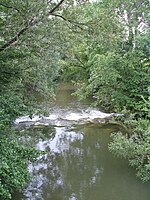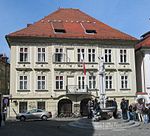Jek Bridge
20th-century architecture in SloveniaBridges completed in 1903Bridges in LjubljanaBridges over the GradaščicaEuropean bridge (structure) stubs ... and 4 more
Road bridges in SloveniaSlovenia transport stubsSlovenian building and structure stubsTrnovo District

The Jek Bridge (Slovene: Jekarski most; also Jeklarski most, Jekavski most, Razorčev most 'Razorec Bridge') is a bridge crossing the Gradaščica River in Ljubljana, the capital of Slovenia. The current structure was built in 1903 at the site of an earlier wooden bridge.The various names are derived from the toponym na Jeku (literally, 'on the hill' < German Ecke), which referred to a nearby wharf, and from the former Razorec Inn, located at Church Street (Cerkvena ulica) no. 1, today (Ernest) Eypper Street (Eipprova ulica).
Excerpt from the Wikipedia article Jek Bridge (License: CC BY-SA 3.0, Authors, Images).Jek Bridge
Krakovski nasip, Ljubljana Trnovo
Geographical coordinates (GPS) Address Nearby Places Show on map
Geographical coordinates (GPS)
| Latitude | Longitude |
|---|---|
| N 46.043780555556 ° | E 14.5054 ° |
Address
Krakovski nasip
1115 Ljubljana, Trnovo
Slovenia
Open on Google Maps







